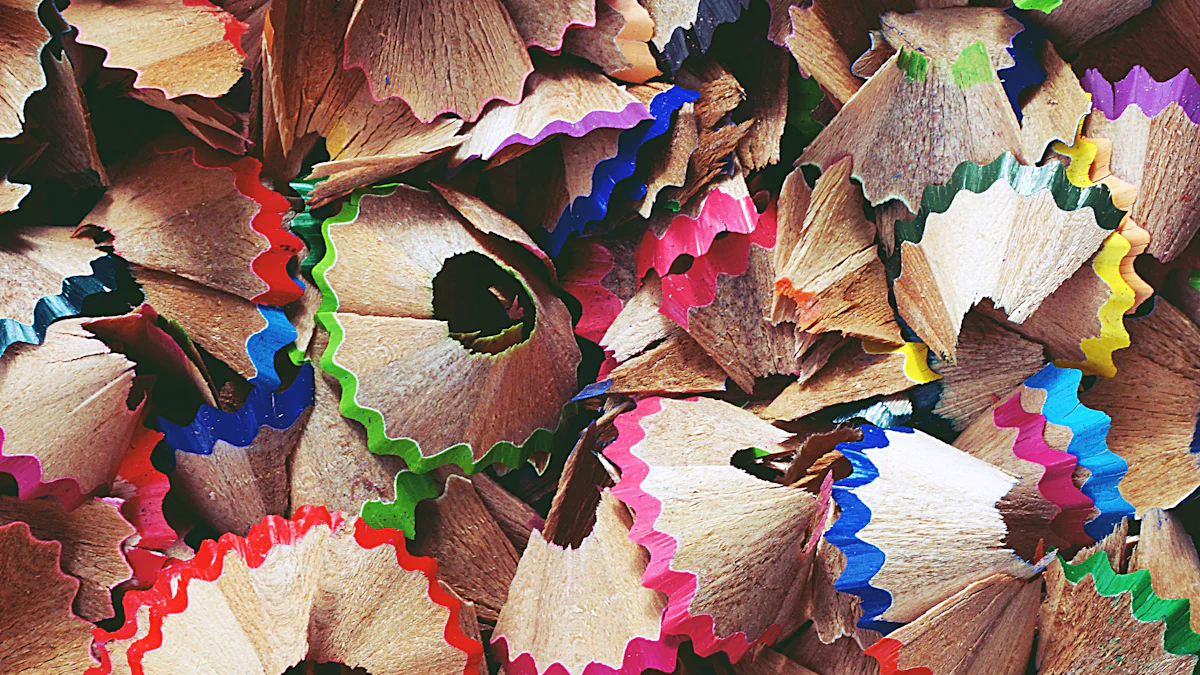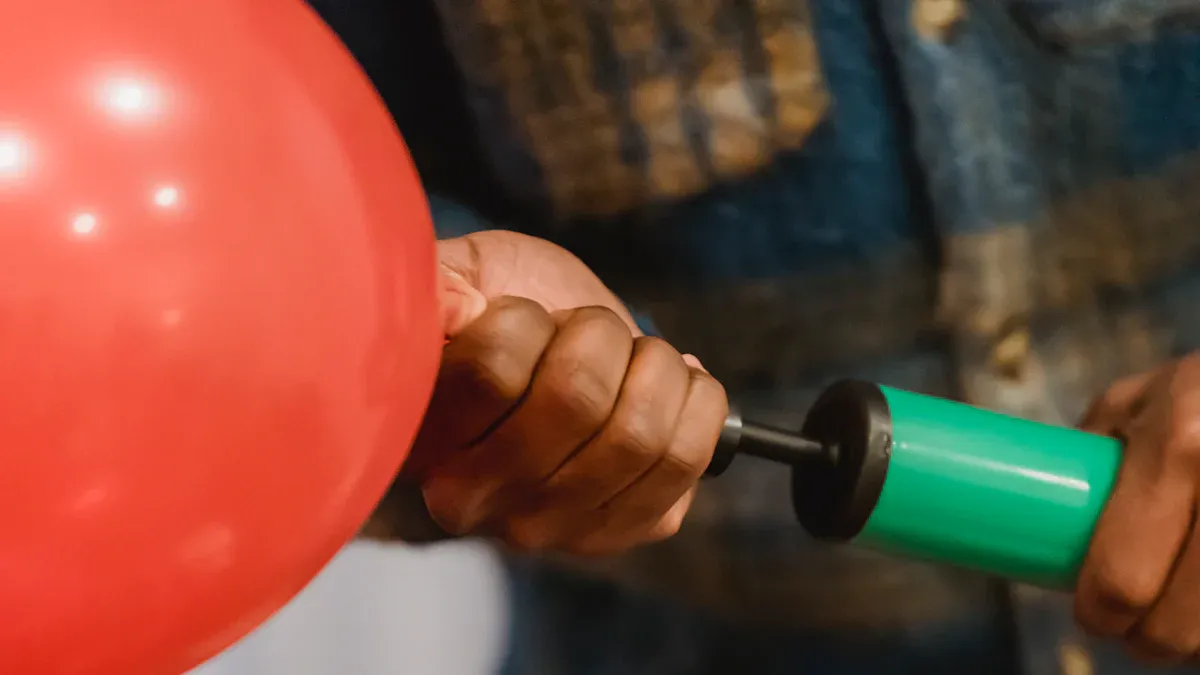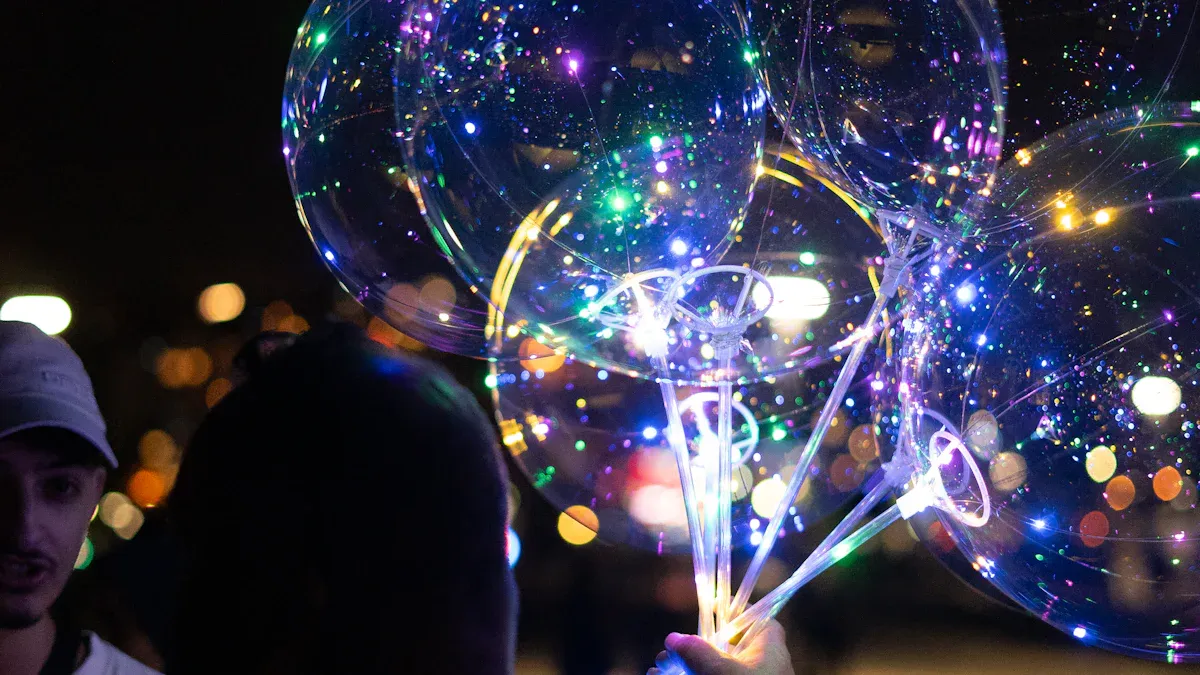
Biodegradable balloons are crafted from natural latex, a material that decomposes over time. These biodegradable balloons provide an eco-friendly alternative to traditional options, which can linger in the environment for years. Traditional balloons pose a threat to wildlife when animals ingest or become entangled in them. In contrast, biodegradable balloons break down more quickly, minimizing risks to ecosystems and wildlife.
Key Takeaways
Biodegradable balloons are made from natural latex. They break down faster than regular balloons and harm the environment less.
However, they can still hurt animals if not thrown away correctly. Animals might eat them or get tangled in them.
Try using eco-friendly choices like cloth decorations or compostable items. This helps you celebrate responsibly and create less trash.
What Are Biodegradable Balloons?
Materials Used in Biodegradable Balloons
Biodegradable balloons are made from biodegradable latex rubber, a natural material derived from the sap of the Hevea brasiliensis tree. This sap is collected sustainably, making it a renewable resource. Unlike synthetic materials, biodegradable latex balloons do not contain harmful chemicals or petroleum-based components. They are free from plastics, ensuring they break down naturally over time.
The latex used in these balloons is elastic, durable, and soft, making it ideal for creating balloons that can hold air or water. Compostable balloons, which are similar to biodegradable balloons, also use natural latex. These materials ensure that biodegradable water balloons and other types of balloons decompose without leaving harmful residues in the environment. By choosing balloons made from natural latex, you support eco-friendly practices and reduce plastic waste.
How Biodegradable Balloons Differ from Traditional Balloons
Biodegradable balloons differ significantly from traditional balloons in their materials and environmental impact. Traditional balloons are often made from synthetic latex or mylar, both of which are petroleum-based and non-biodegradable. These materials can persist in the environment for decades, posing risks to wildlife and ecosystems.
Aspect | Natural Latex | Synthetic Latex |
|---|---|---|
Source | Derived from the sap of rubber trees | Made from petroleum-based chemicals |
Chemical Composition | Composed of natural proteins | Made of chemicals like styrene and butadiene |
Properties | Durable, elastic, and soft | Generally less elastic, firmer feel |
Environmental Impact | Renewable, biodegradable, sustainably harvested | Not biodegradable, non-renewable resources |
Cost | Generally more expensive, but competitive here | Generally less expensive |
Biodegradable latex balloons decompose faster than traditional balloons. Microbial action breaks them down into harmless substances, reducing the risk of harm to animals. Traditional balloons, on the other hand, can entangle or be ingested by wildlife, leading to severe consequences. By choosing biodegradable balloons, you help protect the environment and promote sustainability.
Traditional balloons made from synthetic materials like mylar or plastic can take hundreds of years to decompose. Biodegradable balloons, crafted from natural latex, decompose faster and do not contribute to plastic pollution. This makes them a safer and more sustainable choice for celebrations.
How Do Biodegradable Balloons Decompose?
The Decomposition Process of Biodegradable Balloons
Biodegradable balloons break down through natural processes involving sunlight, oxygen, and microorganisms. When exposed to sunlight, ultraviolet (UV) rays weaken the latex structure, initiating the degradation process. Oxygen further accelerates this by facilitating oxidation, which breaks down the molecular bonds in the material. Moisture plays a crucial role as well, helping to weaken the latex and making it easier for bacteria and fungi to decompose the material into simpler compounds.
The table below outlines the key steps in the decomposition process:
Process | Description |
|---|---|
Exposure | Sunlight and moisture start breaking down the material. |
Microorganisms | Bacteria and fungi consume the latex, converting it into simpler substances. |
Breakdown | The material transforms into water, carbon dioxide, methane, and biomass. |
Sunlight | UV rays weaken the balloon’s structure, aiding degradation. |
Oxygen | Oxidation accelerates the breakdown of latex. |
Moisture | Helps break molecular bonds, speeding up decomposition. |
This natural process ensures that biodegradable balloons return to the earth without causing long-term harm.
Factors Influencing How Fast Biodegradable Balloons Degrade
Several environmental factors determine how fast biodegradable balloons degrade. High humidity levels weaken the latex, making it easier for microorganisms to break it down. Warm temperatures speed up the process, while colder climates slow it down. Direct sunlight accelerates degradation by breaking down the latex structure through UV radiation.
Factor | Influence on Decomposition |
|---|---|
Humidity | High moisture weakens latex, accelerating breakdown. |
Temperature | Warm conditions speed up decomposition; cooler slows it. |
Sunlight | UV rays degrade latex faster in direct sunlight. |
If balloons are inflated, the stress on the material can also increase the rate of degradation. This happens because ozone and oxidation attack the stretched latex, causing it to break down more quickly.
How Long Does It Take for Biodegradable Balloons to Decompose?
The time it takes for biodegradable balloons to fully decompose varies depending on environmental conditions. In ideal settings with high humidity, warm temperatures, and direct sunlight, the process can take months. However, research shows that under natural conditions, these balloons may take 15 years or longer to completely break down. While this is significantly faster than traditional balloons, which can persist for hundreds of years, it still highlights the need for caution when using biodegradable balloons.
Biodegradable balloons decompose faster than traditional ones, but their prolonged presence in the environment can still pose risks to wildlife and ecosystems. Always consider the environmental impact before using them.
Are Biodegradable Balloons Truly Eco-Friendly?
Environmental Impact of Biodegradable Balloons
Biodegradable balloons may seem like an environmentally friendly option, but their impact is more complex than it appears. These balloons require specific conditions, such as high humidity, sunlight, and warm temperatures, to break down effectively. Without these factors, they can persist in the environment for years. For example, a study by the Institute for Marine and Antarctic Studies found that biodegradable balloons remained intact after 16 weeks in an industrial compost heap. This shows that even in controlled environments, they do not decompose as quickly as claimed.
The manufacturing process also raises concerns. While natural latex is renewable, the addition of chemical fillers and pigments can leave harmful residues in soil and water. These residues disrupt soil composition and may affect water quality during decomposition. Although biodegradable balloons break down faster than traditional ones, they still contribute to litter and pose risks to ecosystems.
Risks to Wildlife and Ecosystems
Improperly disposed biodegradable balloons can harm wildlife. Marine animals often mistake balloon fragments for food, leading to fatal digestive blockages. For instance, sea turtles confuse balloons with jellyfish, which can result in starvation. Balloon strings also entangle animals, preventing them from swimming or feeding. A documented case in the UK involved a seagull dying after becoming entangled in a balloon string. These risks highlight that even biodegradable balloons can threaten ecosystems during their decomposition period.
Myths About Biodegradable Balloons
Many misconceptions surround biodegradable balloons. Marketing claims often portray them as eco-friendly balloons that decompose quickly, but this is misleading. Research shows they can take months or even years to break down, depending on environmental conditions. The claim that they decompose at the same rate as an oak leaf is also inaccurate, as oak leaves do not pose choking hazards to animals. Additionally, the presence of dyes and chemical additives makes these balloons far from compostable or recyclable. These factors suggest that the concept of biodegradable balloons as an eco-friendly choice is largely greenwashing.
Biodegradable Balloon Alternatives

Creative and Sustainable Celebration Ideas
You can make your celebrations both festive and sustainable by exploring creative alternatives to balloons. Bunting or garlands crafted from fabric, paper, or natural materials add a colorful and reusable touch to any event. Paper decorations like origami, pinwheels, or pom-poms made from recyclable materials are another eco-friendly option. Lanterns, whether made of paper or fabric, provide a warm and reusable decorative element.
For a whimsical touch, soap bubbles offer a fun and waste-free alternative. You can also use plant-based decor, such as flowers, leaves, or potted plants, which are fully compostable. Chalk art is another unique idea. Create vibrant designs on sidewalks or chalkboards, leaving no waste behind. Reusable ribbon streamers bring bright colors to your event and can be stored for future use. These ideas not only reduce waste but also inspire creativity.
Reusable and Compostable Decoration Options
Reusable decorations can replace single-use items like balloons while maintaining a festive atmosphere. Fabric bunting, flags, or garlands are durable and customizable. Painted wooden figures, wreaths made from natural materials, and fabric ornaments add charm to your event. Plants in painted pots or flowers in vases double as decor and gifts for guests.
Compostable options also work well for eco-conscious celebrations. Rice paper decorations, such as garlands or streamers, decompose naturally. Rustic centerpieces made from twigs or branches bring a natural aesthetic. Eco-friendly piñatas crafted from recycled materials are both fun and biodegradable. You can also use biodegradable plates made from palm leaves or sugarcane for serving food. These choices ensure your event remains sustainable while reducing environmental impact.
Biodegradable balloons, made from natural latex, aim to reduce environmental harm by decomposing faster than traditional balloons. However, they still pose risks to wildlife and ecosystems, especially when improperly disposed of. Their decomposition depends on specific conditions, and chemical additives can leave harmful residues. Consider sustainable alternatives like reusable decorations or compostable options to celebrate responsibly.
FAQ
What makes biodegradable balloons different from compostable balloons?
Biodegradable balloons break down naturally over time, but compostable balloons decompose into nutrient-rich material under specific conditions. Compostable options are better for enriching soil after disposal.
Can you recycle biodegradable balloons?
No, you cannot recycle biodegradable balloons. They are designed to decompose naturally and do not fit into standard recycling processes. Proper disposal ensures minimal environmental impact.
Are biodegradable balloons safe for animals?
Biodegradable balloons still pose risks to animals if ingested or entangled. Always dispose of them responsibly to prevent harm to wildlife and ecosystems.
































